University Project: Limited Medicare Hospice Access and Strategies
VerifiedAdded on 2022/08/27
|11
|2931
|16
Report
AI Summary
This final project report addresses the critical issue of limited access to Medicare hospice services for patients requiring palliative care. The report begins with an executive summary highlighting the problem and its contributing factors, including regulatory barriers, stigmas, limitations within the Medicare program, and hospital setting challenges. A contextual analysis provides background on hospice care in the US, its evolution, and the socio-political influences impacting access. The literature review delves into factors such as patient preferences, eligibility criteria, and the impact of misconceptions. Recommendations are provided to increase awareness, improve reimbursement policies, and facilitate earlier access to palliative care. The report concludes by emphasizing the need for immediate change and offering actionable strategies to improve the quality of care for individuals with terminal illnesses. The report underscores the importance of addressing myths and misconceptions, reforming reimbursement models, and integrating palliative care to ensure timely access to hospice services.
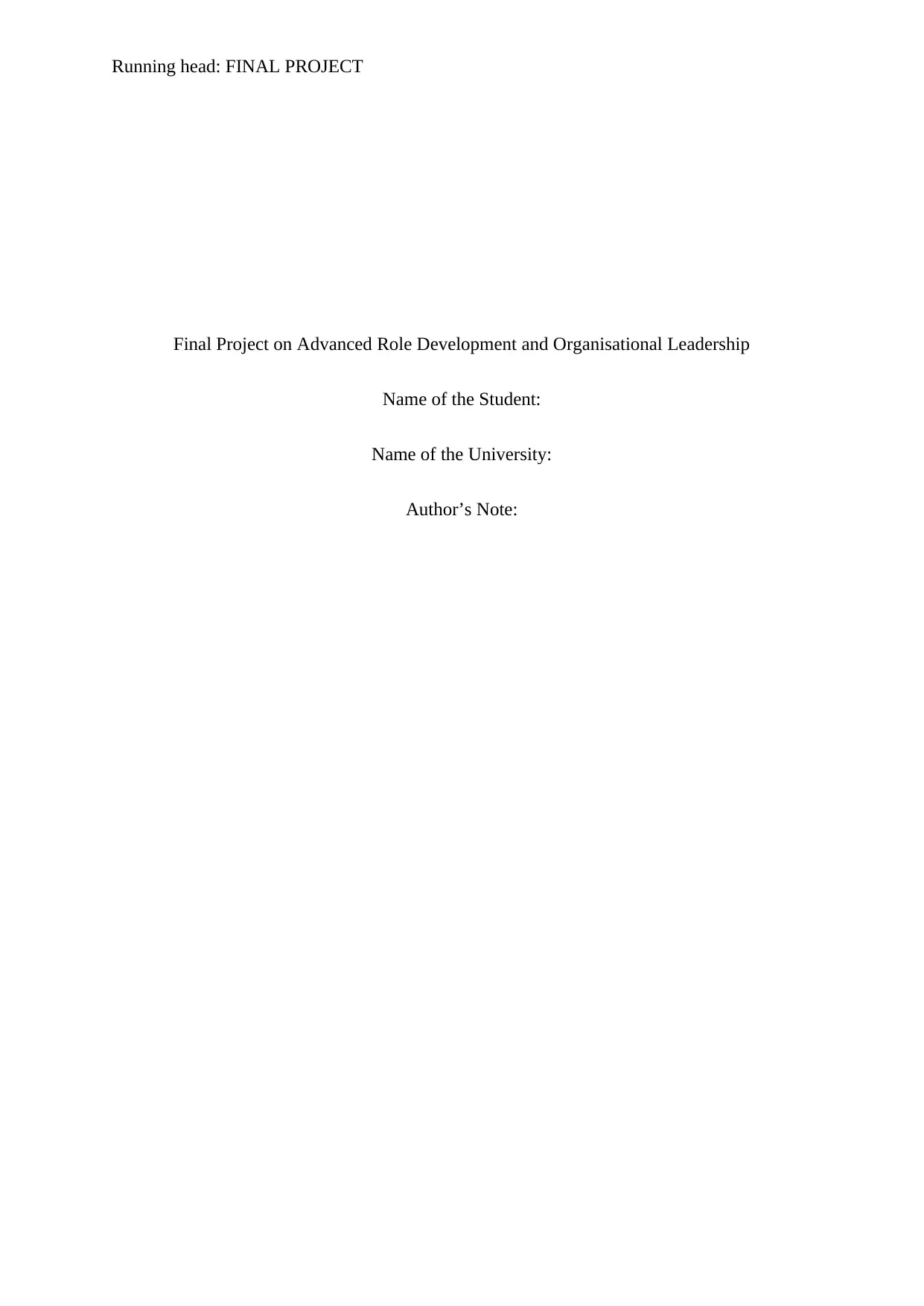
Running head: FINAL PROJECT
Final Project on Advanced Role Development and Organisational Leadership
Name of the Student:
Name of the University:
Author’s Note:
Final Project on Advanced Role Development and Organisational Leadership
Name of the Student:
Name of the University:
Author’s Note:
Paraphrase This Document
Need a fresh take? Get an instant paraphrase of this document with our AI Paraphraser
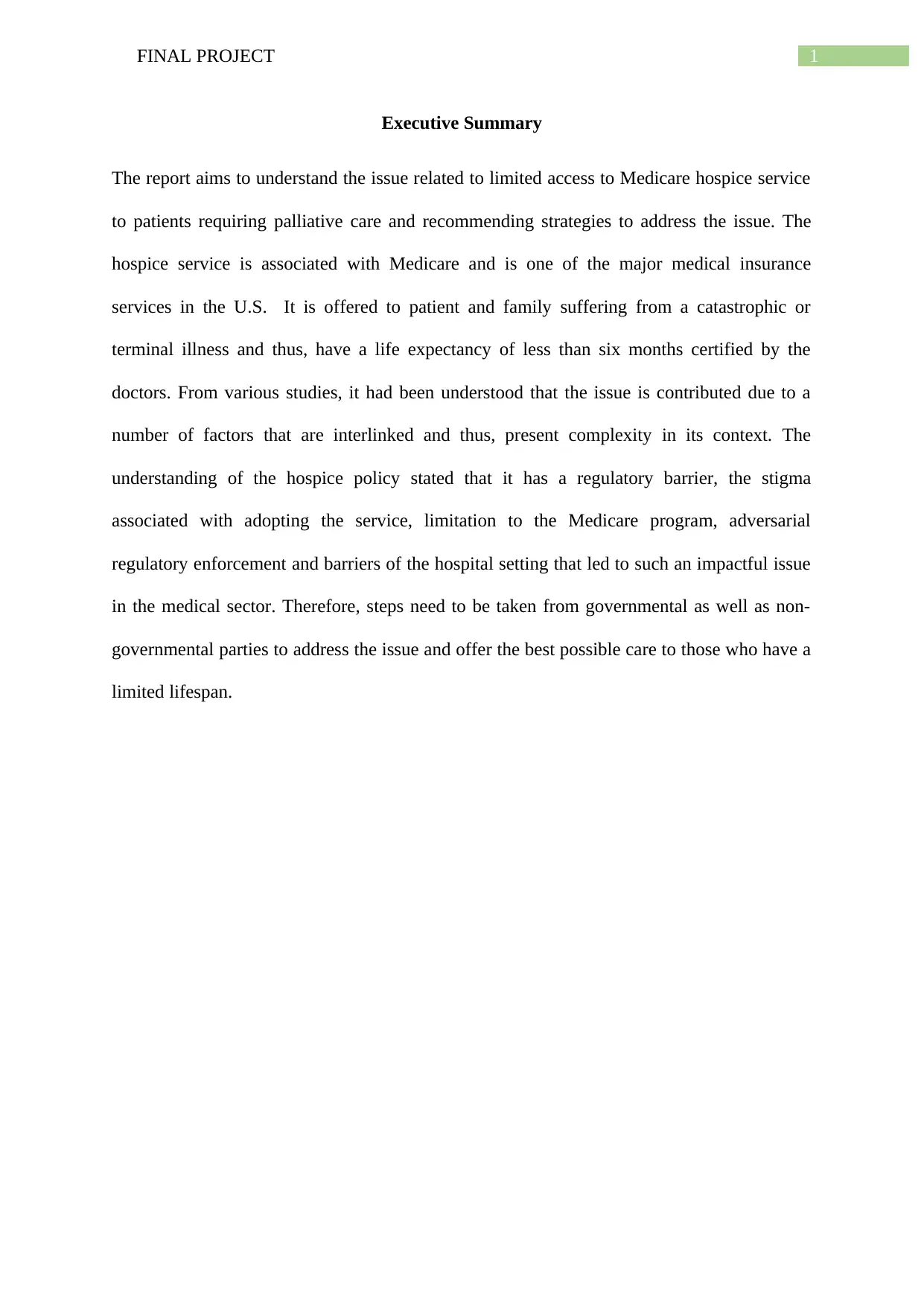
1FINAL PROJECT
Executive Summary
The report aims to understand the issue related to limited access to Medicare hospice service
to patients requiring palliative care and recommending strategies to address the issue. The
hospice service is associated with Medicare and is one of the major medical insurance
services in the U.S. It is offered to patient and family suffering from a catastrophic or
terminal illness and thus, have a life expectancy of less than six months certified by the
doctors. From various studies, it had been understood that the issue is contributed due to a
number of factors that are interlinked and thus, present complexity in its context. The
understanding of the hospice policy stated that it has a regulatory barrier, the stigma
associated with adopting the service, limitation to the Medicare program, adversarial
regulatory enforcement and barriers of the hospital setting that led to such an impactful issue
in the medical sector. Therefore, steps need to be taken from governmental as well as non-
governmental parties to address the issue and offer the best possible care to those who have a
limited lifespan.
Executive Summary
The report aims to understand the issue related to limited access to Medicare hospice service
to patients requiring palliative care and recommending strategies to address the issue. The
hospice service is associated with Medicare and is one of the major medical insurance
services in the U.S. It is offered to patient and family suffering from a catastrophic or
terminal illness and thus, have a life expectancy of less than six months certified by the
doctors. From various studies, it had been understood that the issue is contributed due to a
number of factors that are interlinked and thus, present complexity in its context. The
understanding of the hospice policy stated that it has a regulatory barrier, the stigma
associated with adopting the service, limitation to the Medicare program, adversarial
regulatory enforcement and barriers of the hospital setting that led to such an impactful issue
in the medical sector. Therefore, steps need to be taken from governmental as well as non-
governmental parties to address the issue and offer the best possible care to those who have a
limited lifespan.
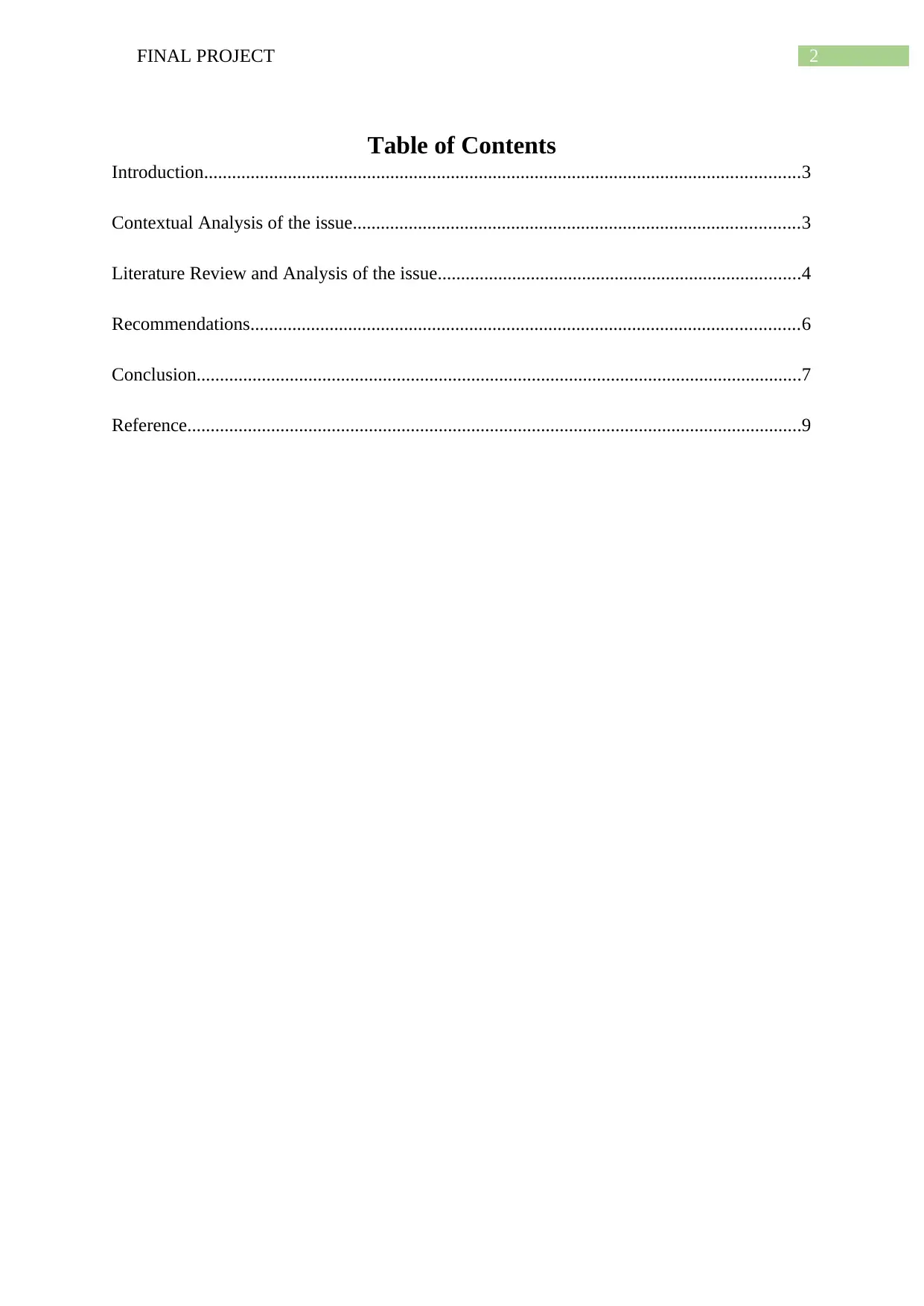
2FINAL PROJECT
Table of Contents
Introduction................................................................................................................................3
Contextual Analysis of the issue................................................................................................3
Literature Review and Analysis of the issue..............................................................................4
Recommendations......................................................................................................................6
Conclusion..................................................................................................................................7
Reference....................................................................................................................................9
Table of Contents
Introduction................................................................................................................................3
Contextual Analysis of the issue................................................................................................3
Literature Review and Analysis of the issue..............................................................................4
Recommendations......................................................................................................................6
Conclusion..................................................................................................................................7
Reference....................................................................................................................................9
⊘ This is a preview!⊘
Do you want full access?
Subscribe today to unlock all pages.

Trusted by 1+ million students worldwide
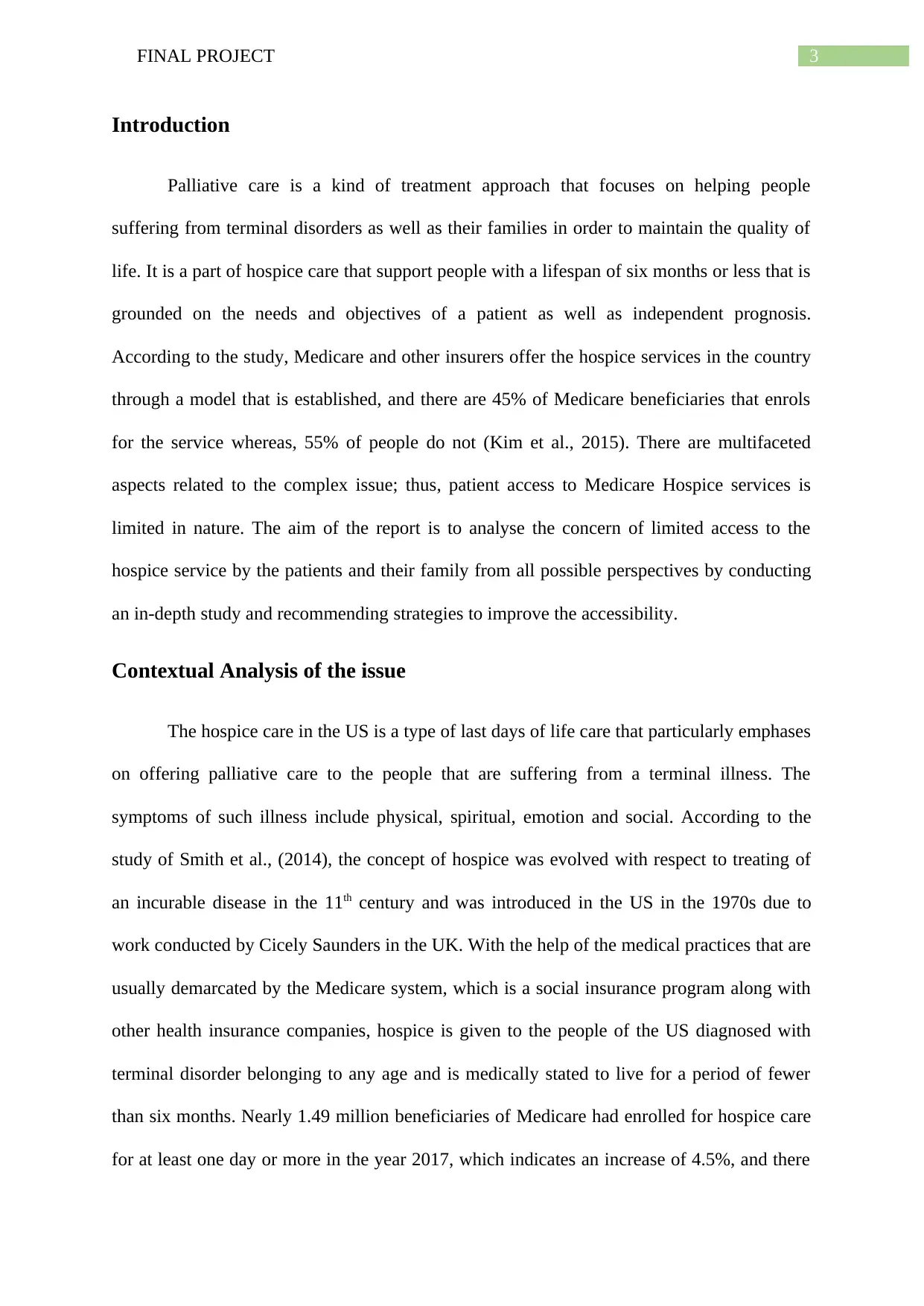
3FINAL PROJECT
Introduction
Palliative care is a kind of treatment approach that focuses on helping people
suffering from terminal disorders as well as their families in order to maintain the quality of
life. It is a part of hospice care that support people with a lifespan of six months or less that is
grounded on the needs and objectives of a patient as well as independent prognosis.
According to the study, Medicare and other insurers offer the hospice services in the country
through a model that is established, and there are 45% of Medicare beneficiaries that enrols
for the service whereas, 55% of people do not (Kim et al., 2015). There are multifaceted
aspects related to the complex issue; thus, patient access to Medicare Hospice services is
limited in nature. The aim of the report is to analyse the concern of limited access to the
hospice service by the patients and their family from all possible perspectives by conducting
an in-depth study and recommending strategies to improve the accessibility.
Contextual Analysis of the issue
The hospice care in the US is a type of last days of life care that particularly emphases
on offering palliative care to the people that are suffering from a terminal illness. The
symptoms of such illness include physical, spiritual, emotion and social. According to the
study of Smith et al., (2014), the concept of hospice was evolved with respect to treating of
an incurable disease in the 11th century and was introduced in the US in the 1970s due to
work conducted by Cicely Saunders in the UK. With the help of the medical practices that are
usually demarcated by the Medicare system, which is a social insurance program along with
other health insurance companies, hospice is given to the people of the US diagnosed with
terminal disorder belonging to any age and is medically stated to live for a period of fewer
than six months. Nearly 1.49 million beneficiaries of Medicare had enrolled for hospice care
for at least one day or more in the year 2017, which indicates an increase of 4.5%, and there
Introduction
Palliative care is a kind of treatment approach that focuses on helping people
suffering from terminal disorders as well as their families in order to maintain the quality of
life. It is a part of hospice care that support people with a lifespan of six months or less that is
grounded on the needs and objectives of a patient as well as independent prognosis.
According to the study, Medicare and other insurers offer the hospice services in the country
through a model that is established, and there are 45% of Medicare beneficiaries that enrols
for the service whereas, 55% of people do not (Kim et al., 2015). There are multifaceted
aspects related to the complex issue; thus, patient access to Medicare Hospice services is
limited in nature. The aim of the report is to analyse the concern of limited access to the
hospice service by the patients and their family from all possible perspectives by conducting
an in-depth study and recommending strategies to improve the accessibility.
Contextual Analysis of the issue
The hospice care in the US is a type of last days of life care that particularly emphases
on offering palliative care to the people that are suffering from a terminal illness. The
symptoms of such illness include physical, spiritual, emotion and social. According to the
study of Smith et al., (2014), the concept of hospice was evolved with respect to treating of
an incurable disease in the 11th century and was introduced in the US in the 1970s due to
work conducted by Cicely Saunders in the UK. With the help of the medical practices that are
usually demarcated by the Medicare system, which is a social insurance program along with
other health insurance companies, hospice is given to the people of the US diagnosed with
terminal disorder belonging to any age and is medically stated to live for a period of fewer
than six months. Nearly 1.49 million beneficiaries of Medicare had enrolled for hospice care
for at least one day or more in the year 2017, which indicates an increase of 4.5%, and there
Paraphrase This Document
Need a fresh take? Get an instant paraphrase of this document with our AI Paraphraser
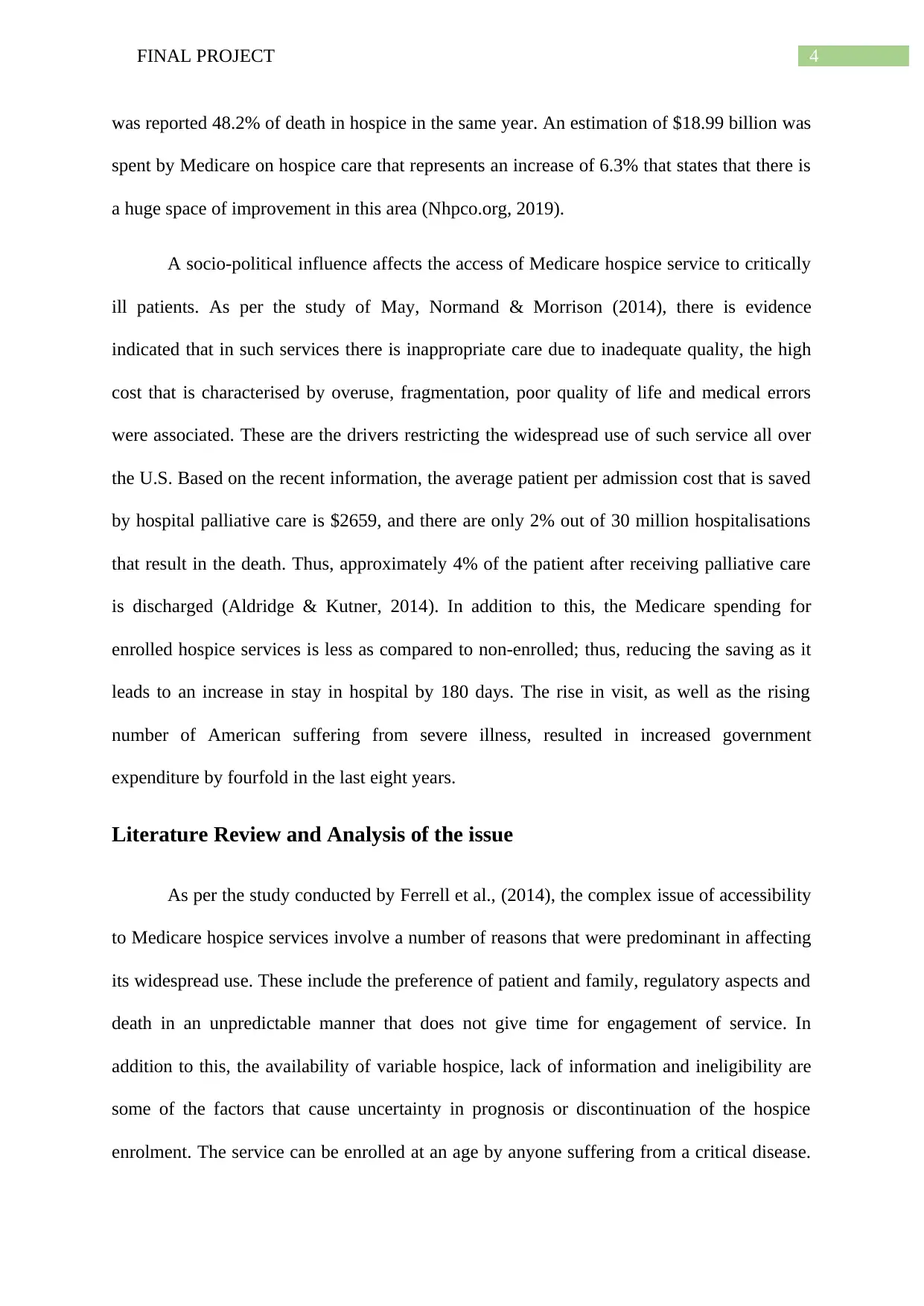
4FINAL PROJECT
was reported 48.2% of death in hospice in the same year. An estimation of $18.99 billion was
spent by Medicare on hospice care that represents an increase of 6.3% that states that there is
a huge space of improvement in this area (Nhpco.org, 2019).
A socio-political influence affects the access of Medicare hospice service to critically
ill patients. As per the study of May, Normand & Morrison (2014), there is evidence
indicated that in such services there is inappropriate care due to inadequate quality, the high
cost that is characterised by overuse, fragmentation, poor quality of life and medical errors
were associated. These are the drivers restricting the widespread use of such service all over
the U.S. Based on the recent information, the average patient per admission cost that is saved
by hospital palliative care is $2659, and there are only 2% out of 30 million hospitalisations
that result in the death. Thus, approximately 4% of the patient after receiving palliative care
is discharged (Aldridge & Kutner, 2014). In addition to this, the Medicare spending for
enrolled hospice services is less as compared to non-enrolled; thus, reducing the saving as it
leads to an increase in stay in hospital by 180 days. The rise in visit, as well as the rising
number of American suffering from severe illness, resulted in increased government
expenditure by fourfold in the last eight years.
Literature Review and Analysis of the issue
As per the study conducted by Ferrell et al., (2014), the complex issue of accessibility
to Medicare hospice services involve a number of reasons that were predominant in affecting
its widespread use. These include the preference of patient and family, regulatory aspects and
death in an unpredictable manner that does not give time for engagement of service. In
addition to this, the availability of variable hospice, lack of information and ineligibility are
some of the factors that cause uncertainty in prognosis or discontinuation of the hospice
enrolment. The service can be enrolled at an age by anyone suffering from a critical disease.
was reported 48.2% of death in hospice in the same year. An estimation of $18.99 billion was
spent by Medicare on hospice care that represents an increase of 6.3% that states that there is
a huge space of improvement in this area (Nhpco.org, 2019).
A socio-political influence affects the access of Medicare hospice service to critically
ill patients. As per the study of May, Normand & Morrison (2014), there is evidence
indicated that in such services there is inappropriate care due to inadequate quality, the high
cost that is characterised by overuse, fragmentation, poor quality of life and medical errors
were associated. These are the drivers restricting the widespread use of such service all over
the U.S. Based on the recent information, the average patient per admission cost that is saved
by hospital palliative care is $2659, and there are only 2% out of 30 million hospitalisations
that result in the death. Thus, approximately 4% of the patient after receiving palliative care
is discharged (Aldridge & Kutner, 2014). In addition to this, the Medicare spending for
enrolled hospice services is less as compared to non-enrolled; thus, reducing the saving as it
leads to an increase in stay in hospital by 180 days. The rise in visit, as well as the rising
number of American suffering from severe illness, resulted in increased government
expenditure by fourfold in the last eight years.
Literature Review and Analysis of the issue
As per the study conducted by Ferrell et al., (2014), the complex issue of accessibility
to Medicare hospice services involve a number of reasons that were predominant in affecting
its widespread use. These include the preference of patient and family, regulatory aspects and
death in an unpredictable manner that does not give time for engagement of service. In
addition to this, the availability of variable hospice, lack of information and ineligibility are
some of the factors that cause uncertainty in prognosis or discontinuation of the hospice
enrolment. The service can be enrolled at an age by anyone suffering from a critical disease.
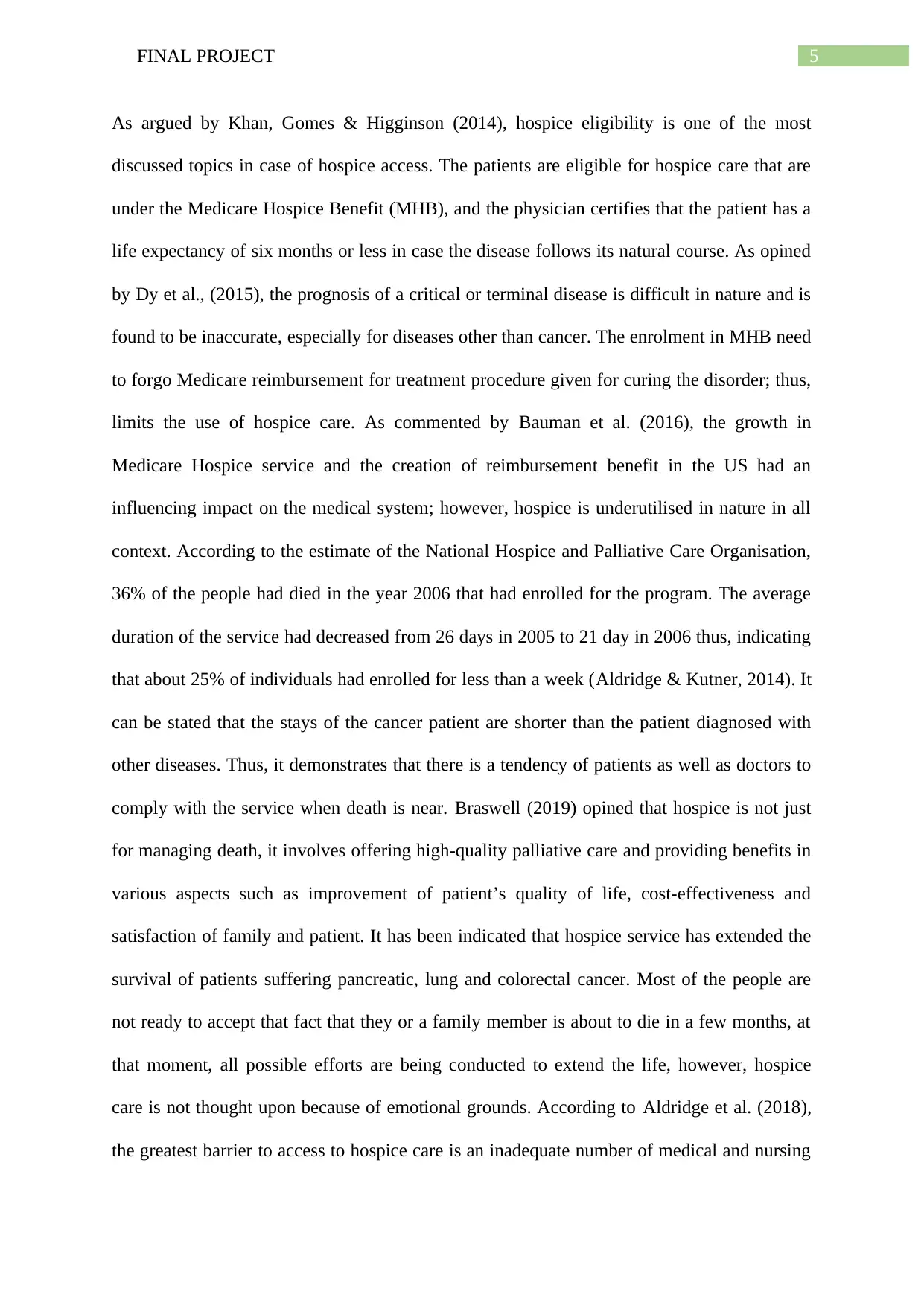
5FINAL PROJECT
As argued by Khan, Gomes & Higginson (2014), hospice eligibility is one of the most
discussed topics in case of hospice access. The patients are eligible for hospice care that are
under the Medicare Hospice Benefit (MHB), and the physician certifies that the patient has a
life expectancy of six months or less in case the disease follows its natural course. As opined
by Dy et al., (2015), the prognosis of a critical or terminal disease is difficult in nature and is
found to be inaccurate, especially for diseases other than cancer. The enrolment in MHB need
to forgo Medicare reimbursement for treatment procedure given for curing the disorder; thus,
limits the use of hospice care. As commented by Bauman et al. (2016), the growth in
Medicare Hospice service and the creation of reimbursement benefit in the US had an
influencing impact on the medical system; however, hospice is underutilised in nature in all
context. According to the estimate of the National Hospice and Palliative Care Organisation,
36% of the people had died in the year 2006 that had enrolled for the program. The average
duration of the service had decreased from 26 days in 2005 to 21 day in 2006 thus, indicating
that about 25% of individuals had enrolled for less than a week (Aldridge & Kutner, 2014). It
can be stated that the stays of the cancer patient are shorter than the patient diagnosed with
other diseases. Thus, it demonstrates that there is a tendency of patients as well as doctors to
comply with the service when death is near. Braswell (2019) opined that hospice is not just
for managing death, it involves offering high-quality palliative care and providing benefits in
various aspects such as improvement of patient’s quality of life, cost-effectiveness and
satisfaction of family and patient. It has been indicated that hospice service has extended the
survival of patients suffering pancreatic, lung and colorectal cancer. Most of the people are
not ready to accept that fact that they or a family member is about to die in a few months, at
that moment, all possible efforts are being conducted to extend the life, however, hospice
care is not thought upon because of emotional grounds. According to Aldridge et al. (2018),
the greatest barrier to access to hospice care is an inadequate number of medical and nursing
As argued by Khan, Gomes & Higginson (2014), hospice eligibility is one of the most
discussed topics in case of hospice access. The patients are eligible for hospice care that are
under the Medicare Hospice Benefit (MHB), and the physician certifies that the patient has a
life expectancy of six months or less in case the disease follows its natural course. As opined
by Dy et al., (2015), the prognosis of a critical or terminal disease is difficult in nature and is
found to be inaccurate, especially for diseases other than cancer. The enrolment in MHB need
to forgo Medicare reimbursement for treatment procedure given for curing the disorder; thus,
limits the use of hospice care. As commented by Bauman et al. (2016), the growth in
Medicare Hospice service and the creation of reimbursement benefit in the US had an
influencing impact on the medical system; however, hospice is underutilised in nature in all
context. According to the estimate of the National Hospice and Palliative Care Organisation,
36% of the people had died in the year 2006 that had enrolled for the program. The average
duration of the service had decreased from 26 days in 2005 to 21 day in 2006 thus, indicating
that about 25% of individuals had enrolled for less than a week (Aldridge & Kutner, 2014). It
can be stated that the stays of the cancer patient are shorter than the patient diagnosed with
other diseases. Thus, it demonstrates that there is a tendency of patients as well as doctors to
comply with the service when death is near. Braswell (2019) opined that hospice is not just
for managing death, it involves offering high-quality palliative care and providing benefits in
various aspects such as improvement of patient’s quality of life, cost-effectiveness and
satisfaction of family and patient. It has been indicated that hospice service has extended the
survival of patients suffering pancreatic, lung and colorectal cancer. Most of the people are
not ready to accept that fact that they or a family member is about to die in a few months, at
that moment, all possible efforts are being conducted to extend the life, however, hospice
care is not thought upon because of emotional grounds. According to Aldridge et al. (2018),
the greatest barrier to access to hospice care is an inadequate number of medical and nursing
⊘ This is a preview!⊘
Do you want full access?
Subscribe today to unlock all pages.

Trusted by 1+ million students worldwide
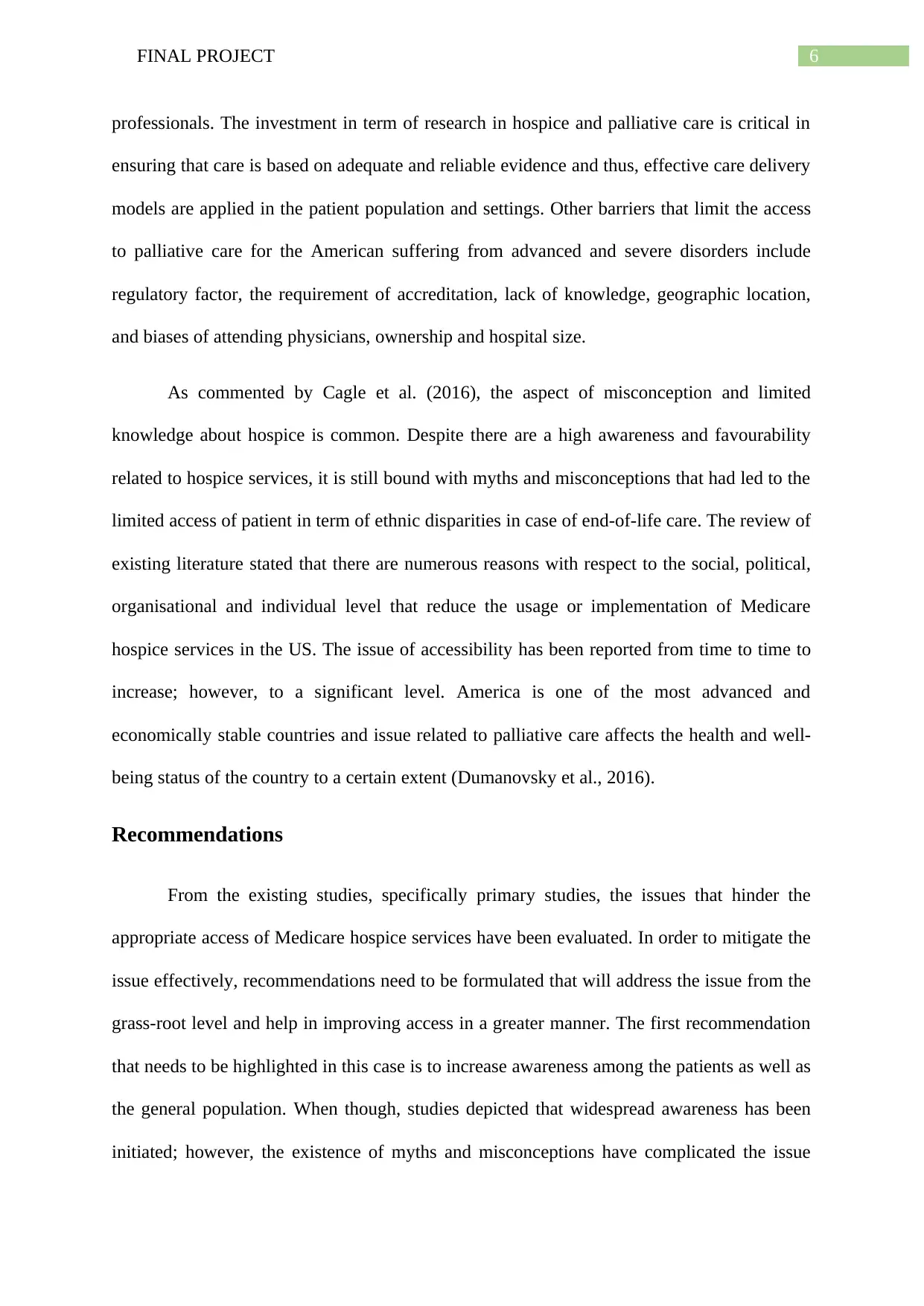
6FINAL PROJECT
professionals. The investment in term of research in hospice and palliative care is critical in
ensuring that care is based on adequate and reliable evidence and thus, effective care delivery
models are applied in the patient population and settings. Other barriers that limit the access
to palliative care for the American suffering from advanced and severe disorders include
regulatory factor, the requirement of accreditation, lack of knowledge, geographic location,
and biases of attending physicians, ownership and hospital size.
As commented by Cagle et al. (2016), the aspect of misconception and limited
knowledge about hospice is common. Despite there are a high awareness and favourability
related to hospice services, it is still bound with myths and misconceptions that had led to the
limited access of patient in term of ethnic disparities in case of end-of-life care. The review of
existing literature stated that there are numerous reasons with respect to the social, political,
organisational and individual level that reduce the usage or implementation of Medicare
hospice services in the US. The issue of accessibility has been reported from time to time to
increase; however, to a significant level. America is one of the most advanced and
economically stable countries and issue related to palliative care affects the health and well-
being status of the country to a certain extent (Dumanovsky et al., 2016).
Recommendations
From the existing studies, specifically primary studies, the issues that hinder the
appropriate access of Medicare hospice services have been evaluated. In order to mitigate the
issue effectively, recommendations need to be formulated that will address the issue from the
grass-root level and help in improving access in a greater manner. The first recommendation
that needs to be highlighted in this case is to increase awareness among the patients as well as
the general population. When though, studies depicted that widespread awareness has been
initiated; however, the existence of myths and misconceptions have complicated the issue
professionals. The investment in term of research in hospice and palliative care is critical in
ensuring that care is based on adequate and reliable evidence and thus, effective care delivery
models are applied in the patient population and settings. Other barriers that limit the access
to palliative care for the American suffering from advanced and severe disorders include
regulatory factor, the requirement of accreditation, lack of knowledge, geographic location,
and biases of attending physicians, ownership and hospital size.
As commented by Cagle et al. (2016), the aspect of misconception and limited
knowledge about hospice is common. Despite there are a high awareness and favourability
related to hospice services, it is still bound with myths and misconceptions that had led to the
limited access of patient in term of ethnic disparities in case of end-of-life care. The review of
existing literature stated that there are numerous reasons with respect to the social, political,
organisational and individual level that reduce the usage or implementation of Medicare
hospice services in the US. The issue of accessibility has been reported from time to time to
increase; however, to a significant level. America is one of the most advanced and
economically stable countries and issue related to palliative care affects the health and well-
being status of the country to a certain extent (Dumanovsky et al., 2016).
Recommendations
From the existing studies, specifically primary studies, the issues that hinder the
appropriate access of Medicare hospice services have been evaluated. In order to mitigate the
issue effectively, recommendations need to be formulated that will address the issue from the
grass-root level and help in improving access in a greater manner. The first recommendation
that needs to be highlighted in this case is to increase awareness among the patients as well as
the general population. When though, studies depicted that widespread awareness has been
initiated; however, the existence of myths and misconceptions have complicated the issue
Paraphrase This Document
Need a fresh take? Get an instant paraphrase of this document with our AI Paraphraser
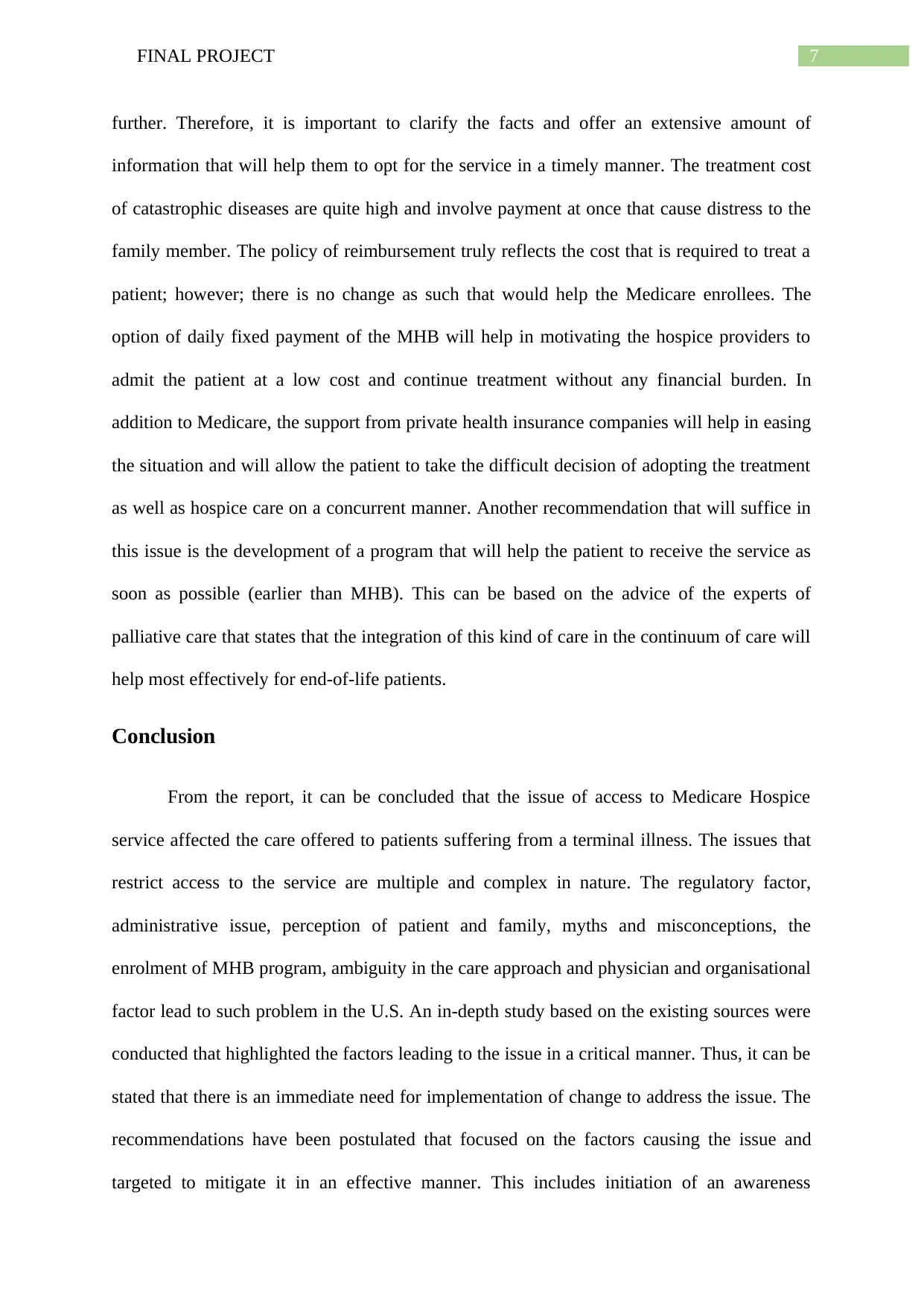
7FINAL PROJECT
further. Therefore, it is important to clarify the facts and offer an extensive amount of
information that will help them to opt for the service in a timely manner. The treatment cost
of catastrophic diseases are quite high and involve payment at once that cause distress to the
family member. The policy of reimbursement truly reflects the cost that is required to treat a
patient; however; there is no change as such that would help the Medicare enrollees. The
option of daily fixed payment of the MHB will help in motivating the hospice providers to
admit the patient at a low cost and continue treatment without any financial burden. In
addition to Medicare, the support from private health insurance companies will help in easing
the situation and will allow the patient to take the difficult decision of adopting the treatment
as well as hospice care on a concurrent manner. Another recommendation that will suffice in
this issue is the development of a program that will help the patient to receive the service as
soon as possible (earlier than MHB). This can be based on the advice of the experts of
palliative care that states that the integration of this kind of care in the continuum of care will
help most effectively for end-of-life patients.
Conclusion
From the report, it can be concluded that the issue of access to Medicare Hospice
service affected the care offered to patients suffering from a terminal illness. The issues that
restrict access to the service are multiple and complex in nature. The regulatory factor,
administrative issue, perception of patient and family, myths and misconceptions, the
enrolment of MHB program, ambiguity in the care approach and physician and organisational
factor lead to such problem in the U.S. An in-depth study based on the existing sources were
conducted that highlighted the factors leading to the issue in a critical manner. Thus, it can be
stated that there is an immediate need for implementation of change to address the issue. The
recommendations have been postulated that focused on the factors causing the issue and
targeted to mitigate it in an effective manner. This includes initiation of an awareness
further. Therefore, it is important to clarify the facts and offer an extensive amount of
information that will help them to opt for the service in a timely manner. The treatment cost
of catastrophic diseases are quite high and involve payment at once that cause distress to the
family member. The policy of reimbursement truly reflects the cost that is required to treat a
patient; however; there is no change as such that would help the Medicare enrollees. The
option of daily fixed payment of the MHB will help in motivating the hospice providers to
admit the patient at a low cost and continue treatment without any financial burden. In
addition to Medicare, the support from private health insurance companies will help in easing
the situation and will allow the patient to take the difficult decision of adopting the treatment
as well as hospice care on a concurrent manner. Another recommendation that will suffice in
this issue is the development of a program that will help the patient to receive the service as
soon as possible (earlier than MHB). This can be based on the advice of the experts of
palliative care that states that the integration of this kind of care in the continuum of care will
help most effectively for end-of-life patients.
Conclusion
From the report, it can be concluded that the issue of access to Medicare Hospice
service affected the care offered to patients suffering from a terminal illness. The issues that
restrict access to the service are multiple and complex in nature. The regulatory factor,
administrative issue, perception of patient and family, myths and misconceptions, the
enrolment of MHB program, ambiguity in the care approach and physician and organisational
factor lead to such problem in the U.S. An in-depth study based on the existing sources were
conducted that highlighted the factors leading to the issue in a critical manner. Thus, it can be
stated that there is an immediate need for implementation of change to address the issue. The
recommendations have been postulated that focused on the factors causing the issue and
targeted to mitigate it in an effective manner. This includes initiation of an awareness
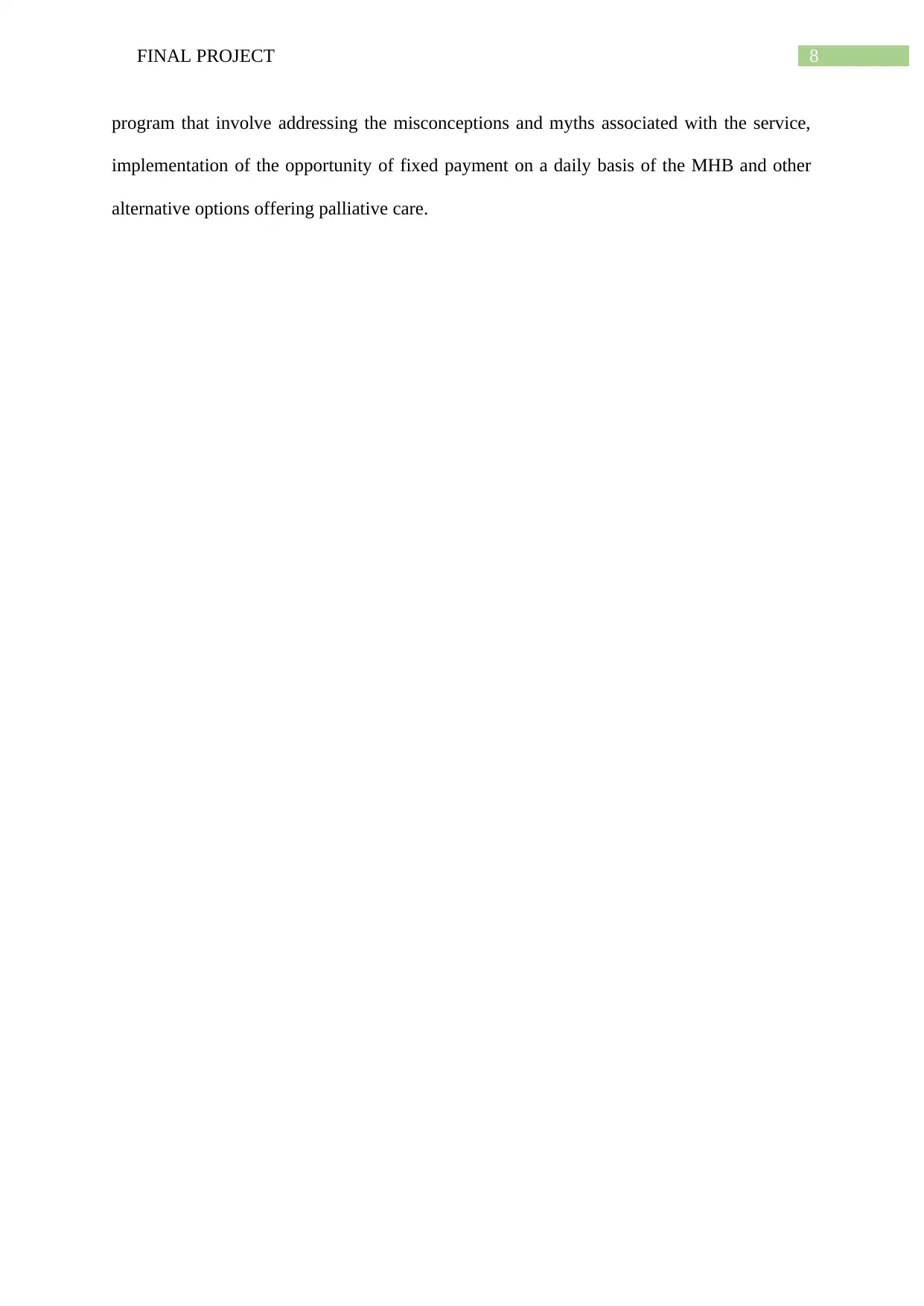
8FINAL PROJECT
program that involve addressing the misconceptions and myths associated with the service,
implementation of the opportunity of fixed payment on a daily basis of the MHB and other
alternative options offering palliative care.
program that involve addressing the misconceptions and myths associated with the service,
implementation of the opportunity of fixed payment on a daily basis of the MHB and other
alternative options offering palliative care.
⊘ This is a preview!⊘
Do you want full access?
Subscribe today to unlock all pages.

Trusted by 1+ million students worldwide
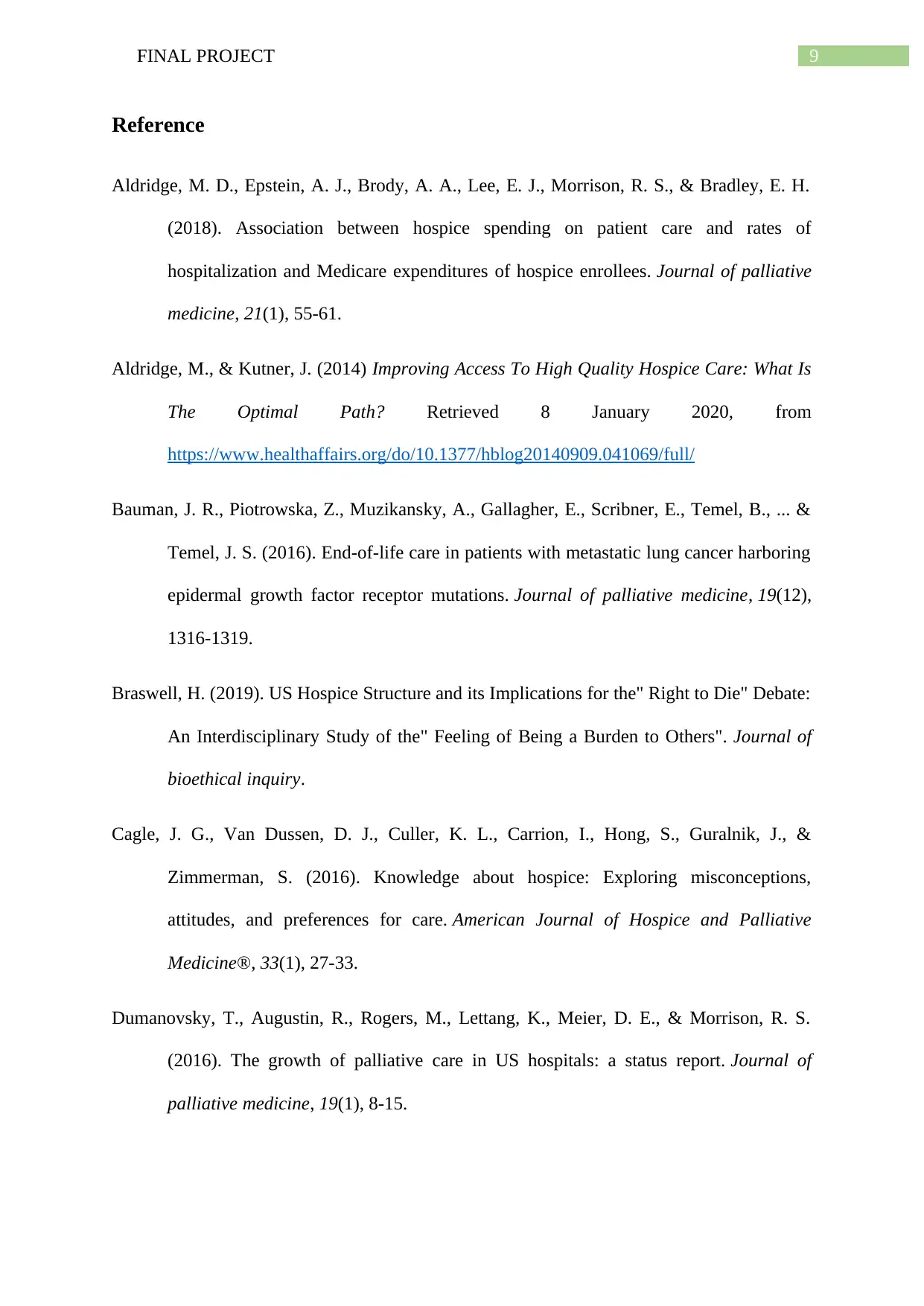
9FINAL PROJECT
Reference
Aldridge, M. D., Epstein, A. J., Brody, A. A., Lee, E. J., Morrison, R. S., & Bradley, E. H.
(2018). Association between hospice spending on patient care and rates of
hospitalization and Medicare expenditures of hospice enrollees. Journal of palliative
medicine, 21(1), 55-61.
Aldridge, M., & Kutner, J. (2014) Improving Access To High Quality Hospice Care: What Is
The Optimal Path? Retrieved 8 January 2020, from
https://www.healthaffairs.org/do/10.1377/hblog20140909.041069/full/
Bauman, J. R., Piotrowska, Z., Muzikansky, A., Gallagher, E., Scribner, E., Temel, B., ... &
Temel, J. S. (2016). End-of-life care in patients with metastatic lung cancer harboring
epidermal growth factor receptor mutations. Journal of palliative medicine, 19(12),
1316-1319.
Braswell, H. (2019). US Hospice Structure and its Implications for the" Right to Die" Debate:
An Interdisciplinary Study of the" Feeling of Being a Burden to Others". Journal of
bioethical inquiry.
Cagle, J. G., Van Dussen, D. J., Culler, K. L., Carrion, I., Hong, S., Guralnik, J., &
Zimmerman, S. (2016). Knowledge about hospice: Exploring misconceptions,
attitudes, and preferences for care. American Journal of Hospice and Palliative
Medicine®, 33(1), 27-33.
Dumanovsky, T., Augustin, R., Rogers, M., Lettang, K., Meier, D. E., & Morrison, R. S.
(2016). The growth of palliative care in US hospitals: a status report. Journal of
palliative medicine, 19(1), 8-15.
Reference
Aldridge, M. D., Epstein, A. J., Brody, A. A., Lee, E. J., Morrison, R. S., & Bradley, E. H.
(2018). Association between hospice spending on patient care and rates of
hospitalization and Medicare expenditures of hospice enrollees. Journal of palliative
medicine, 21(1), 55-61.
Aldridge, M., & Kutner, J. (2014) Improving Access To High Quality Hospice Care: What Is
The Optimal Path? Retrieved 8 January 2020, from
https://www.healthaffairs.org/do/10.1377/hblog20140909.041069/full/
Bauman, J. R., Piotrowska, Z., Muzikansky, A., Gallagher, E., Scribner, E., Temel, B., ... &
Temel, J. S. (2016). End-of-life care in patients with metastatic lung cancer harboring
epidermal growth factor receptor mutations. Journal of palliative medicine, 19(12),
1316-1319.
Braswell, H. (2019). US Hospice Structure and its Implications for the" Right to Die" Debate:
An Interdisciplinary Study of the" Feeling of Being a Burden to Others". Journal of
bioethical inquiry.
Cagle, J. G., Van Dussen, D. J., Culler, K. L., Carrion, I., Hong, S., Guralnik, J., &
Zimmerman, S. (2016). Knowledge about hospice: Exploring misconceptions,
attitudes, and preferences for care. American Journal of Hospice and Palliative
Medicine®, 33(1), 27-33.
Dumanovsky, T., Augustin, R., Rogers, M., Lettang, K., Meier, D. E., & Morrison, R. S.
(2016). The growth of palliative care in US hospitals: a status report. Journal of
palliative medicine, 19(1), 8-15.
Paraphrase This Document
Need a fresh take? Get an instant paraphrase of this document with our AI Paraphraser
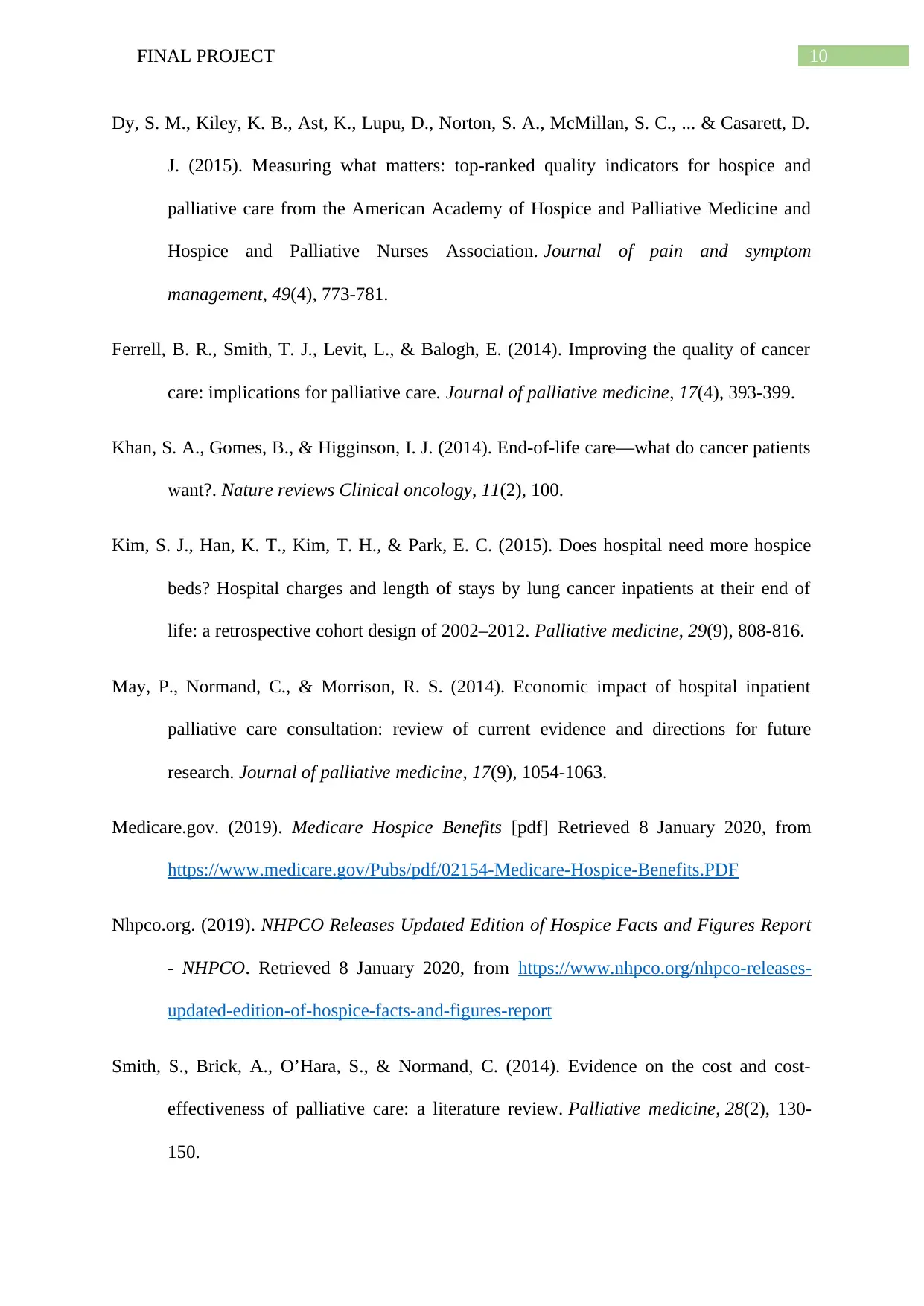
10FINAL PROJECT
Dy, S. M., Kiley, K. B., Ast, K., Lupu, D., Norton, S. A., McMillan, S. C., ... & Casarett, D.
J. (2015). Measuring what matters: top-ranked quality indicators for hospice and
palliative care from the American Academy of Hospice and Palliative Medicine and
Hospice and Palliative Nurses Association. Journal of pain and symptom
management, 49(4), 773-781.
Ferrell, B. R., Smith, T. J., Levit, L., & Balogh, E. (2014). Improving the quality of cancer
care: implications for palliative care. Journal of palliative medicine, 17(4), 393-399.
Khan, S. A., Gomes, B., & Higginson, I. J. (2014). End-of-life care—what do cancer patients
want?. Nature reviews Clinical oncology, 11(2), 100.
Kim, S. J., Han, K. T., Kim, T. H., & Park, E. C. (2015). Does hospital need more hospice
beds? Hospital charges and length of stays by lung cancer inpatients at their end of
life: a retrospective cohort design of 2002–2012. Palliative medicine, 29(9), 808-816.
May, P., Normand, C., & Morrison, R. S. (2014). Economic impact of hospital inpatient
palliative care consultation: review of current evidence and directions for future
research. Journal of palliative medicine, 17(9), 1054-1063.
Medicare.gov. (2019). Medicare Hospice Benefits [pdf] Retrieved 8 January 2020, from
https://www.medicare.gov/Pubs/pdf/02154-Medicare-Hospice-Benefits.PDF
Nhpco.org. (2019). NHPCO Releases Updated Edition of Hospice Facts and Figures Report
- NHPCO. Retrieved 8 January 2020, from https://www.nhpco.org/nhpco-releases-
updated-edition-of-hospice-facts-and-figures-report
Smith, S., Brick, A., O’Hara, S., & Normand, C. (2014). Evidence on the cost and cost-
effectiveness of palliative care: a literature review. Palliative medicine, 28(2), 130-
150.
Dy, S. M., Kiley, K. B., Ast, K., Lupu, D., Norton, S. A., McMillan, S. C., ... & Casarett, D.
J. (2015). Measuring what matters: top-ranked quality indicators for hospice and
palliative care from the American Academy of Hospice and Palliative Medicine and
Hospice and Palliative Nurses Association. Journal of pain and symptom
management, 49(4), 773-781.
Ferrell, B. R., Smith, T. J., Levit, L., & Balogh, E. (2014). Improving the quality of cancer
care: implications for palliative care. Journal of palliative medicine, 17(4), 393-399.
Khan, S. A., Gomes, B., & Higginson, I. J. (2014). End-of-life care—what do cancer patients
want?. Nature reviews Clinical oncology, 11(2), 100.
Kim, S. J., Han, K. T., Kim, T. H., & Park, E. C. (2015). Does hospital need more hospice
beds? Hospital charges and length of stays by lung cancer inpatients at their end of
life: a retrospective cohort design of 2002–2012. Palliative medicine, 29(9), 808-816.
May, P., Normand, C., & Morrison, R. S. (2014). Economic impact of hospital inpatient
palliative care consultation: review of current evidence and directions for future
research. Journal of palliative medicine, 17(9), 1054-1063.
Medicare.gov. (2019). Medicare Hospice Benefits [pdf] Retrieved 8 January 2020, from
https://www.medicare.gov/Pubs/pdf/02154-Medicare-Hospice-Benefits.PDF
Nhpco.org. (2019). NHPCO Releases Updated Edition of Hospice Facts and Figures Report
- NHPCO. Retrieved 8 January 2020, from https://www.nhpco.org/nhpco-releases-
updated-edition-of-hospice-facts-and-figures-report
Smith, S., Brick, A., O’Hara, S., & Normand, C. (2014). Evidence on the cost and cost-
effectiveness of palliative care: a literature review. Palliative medicine, 28(2), 130-
150.
1 out of 11
Related Documents
Your All-in-One AI-Powered Toolkit for Academic Success.
+13062052269
info@desklib.com
Available 24*7 on WhatsApp / Email
![[object Object]](/_next/static/media/star-bottom.7253800d.svg)
Unlock your academic potential
Copyright © 2020–2025 A2Z Services. All Rights Reserved. Developed and managed by ZUCOL.




